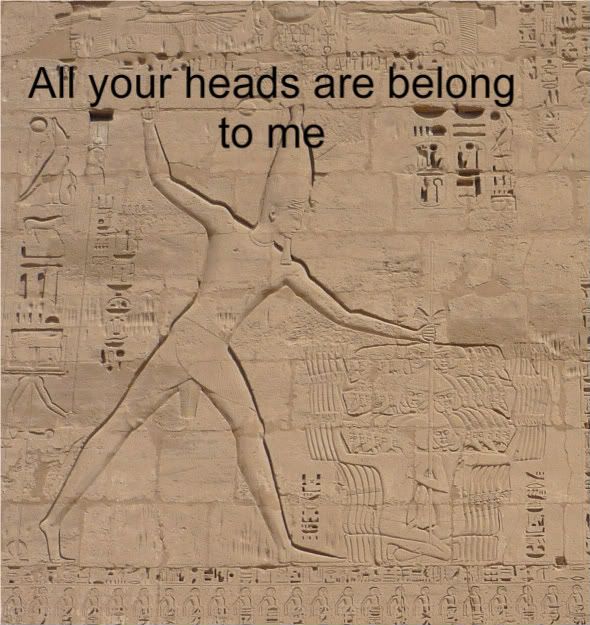A note on chronology and dates
Dates are a funny thing in archaeology and history. I find concrete dates to be pretty annoying and when I taught did not make my students remember more than ballpark figures. Relative chronology is more important for a broad understanding of what's going on. Relative as in x came before y who came before z.
Plus, for a lot of Egyptian history, the dates are a bit wibbly-wobbly timey-wimey. We have spots where we can nail things down based on concretely dated events like the Sothic star cycle or eclipses, etc., but a lot of other periods sort of float – as in we know how many kings there were and how long they each reigned, but nailing that list to dates like 1100 BC is a bit more challenging. And people argue about it all the damn time and there is much blathering about Venus and carbon 14 and dendrochronology and were there co-regencies and what makes a regnal year and were cattle-counts bi-annal or annual and when did Thera erupt and blah, blah, blah. Import for specialists or those who find it interesting. Not that important for understanding the basics.
So, I'm probably not going to do a lot with dates here. Instead, I tend to use broader terms, like Predynastic or New Kingdom or reign of King Whoever.
So, on to the Predynastic.
Long ago, at the dawn of time, aliens came and built a bunch of pyramids and the Sphinx, then buried them in sand and ran away (Note: The previous sentence is total bullshit! ) . Later, humans showed up and were all “this is pretty cool, let's pretend we made it.” Thousands of years later still, people like Eric von Daniken and Graham Hancock and a bunch of other stupid wankers made lots of money and became semi-famous telling people all about the aliens and making up a bunch of other stupid shit to sell books to people who fail at critical thinking. Thanks to them, I spent a fair chunk of my time when I answered email and phonecalls from the public in a professional capacity having to tactfully explain to an enormous number of people why the face on Mars is a coincidence, how yes, there are in fact inscriptions dating to the reign of Khufu inside the Great Freakin' Pyramid, that no, there is not a damn helicopter hieroglyph in the Seti Temple at Abydos, how the ancient Egyptians were not in fact “Aryan” (in the Stormfront/KKK sense of the term), how no, the lack of noses on a large number of statues is probably not due to a vast white conspiracy to hide the African features of the ancient Egyptians, etc., etc. I also got at least one email per week from different retired engineers explaining how the pyramid (sic) was really built and, often, explaining how us dumb Egyptologists would know that if only we'd been bright enough to go to school in engineering.
Now that I no longer need be tactful:
Holy crap did you go to school!?!? How can you be this willfully ignorant!?!? If I put a page up on the internet/wrote a book/made a “documentary” about how the sky is really purple, but the government/Catholic Church/aliens/all of the above is really perpetrating a vast conspiracy to make everyone believe it's blue, would you believe me? Should I overcome my basic sense of ethics in order to take advantage of your credulity? Mr. Engineer, please go look up the word “anachronism” then look at your reconstruction of the building methods of “the” pyramid and then get back to me. All of you: there is more than one pyramid in Egypt! There were pyramids built before and after the Great Pyramid! There were pyramids built in places other than Giza! And if “the pyramid” is “too complicated” for humans possibly to have built all by themselves, why is there not a vibrant subculture busily explaining how aliens built: Luxor and Karnak temples, the Great Wall of China, any extant Roman aqueduct, or any number of things that basically consist of large piles of rock arranged in a logical fashion!?! While you're at it, please explain to me in detail how the Sears Tower was built. No, you may not have access to any historical records, photographs, drawings, blueprints, etc. Go! What's that, you “hypothesize based on available data”!?! Bunk! Aliens. Not only did they build the Sears Tower, they also put the Daley machine in motion. Lalalalala fingers-in-my-ears can't hear your counter-arguments, how dare you intellectual elitists refuse to take my ideas seriously!
Ahem.
The Predynastic. Right. So, for very, very early on in the Paleolithic there's a bit of evidence of Homo erectus wandering around in Egypt in the form of tools and then evidence of both Neanderthal and “ anatomically modern” humans a bit later, including the burial of a human child. There's some good sites for the Upper Paleolithic too, like Wadi Kubbaniya.
The Predynastic really gets moving and shaking in the Neolithic, though. The Neolithic (every where and the actual timing changes from place to place) is when you have continued use of stone tools (like the “Old Stone Age” - “ Paleolithic”) but also start to see other stuff like increased sedentariness, the domestication of plants and animals, and increasing social complexity. This is what most people are talking about when they talk about “the rise of civilization.”
In Egypt, most of our evidence for these social and subsistence changes comes from cemeteries for the reasons I've discussed before – they tend to be the things that are actually preserved. Cemeteries can be really, really handy for indexing changes in social structure if you can make the case that more elaborate burials equal a higher social status. You can also look at who is getting those more elaborate burials to get an idea of whether you're looking at achieved status – in other words, wow, that dude killed a hippo and saved the village and then went drove off those damn foreigners from over the hill and kept them from jacking our stuff – vs. ascribed status – ie the son of that awesome dude who killed the hippo is also awesome because he's that dude's son; he hasn't actually done anything yet, but he might have someday, therefore we will give him cool shit.
Grave goods can be a way to look at subsistence patterns and other information, especially if food items are included with the dead or if tools are. Also, because North Africa was a wetter environment until fairly recently (probably into the Old Kingdom), settlements were established in places that are now desert and so we have some preserved contexts to work with. Very early in the Neolithic, people were still moving around seasonally, but seemed to settle in one place for extended periods, as in a whole season spent in one place in some contexts, taking advantage of whatever resources happen to be there – like fishing on the river or hunting further out in what is now desert, plus collecting various tasty plants.
There's also evidence for cattle herding early in the Neolithic, primarily in Sudan, but also moving up in to Egypt. Cattle are a big deal for much of early Sudanese history. They're important in Egypt as well, but not to quite the same degree. There is increasing evidence as we move through time for other domesticated animals as well. Sheep and goats probably came from Western Asia along with pigs. Dogs had been domesticated forever and are also attested. If you're wondering how on earth you tell if an animal is domesticated from just bits and pieces, it's pretty cool. Domestication often creates some distinct morphological changes in animals, so having someone who knows what to look for check out the remains is really helpful. Age and sex profiles of the animals can also tell you a bit about how they were being managed – you have different kill patterns at different ages depending on use, such as use for meat vs. use for secondary products. Where and how the animal bones are deposited can tell you about processing and cooking, preferred cuts, etc. Very cool.
And, there's pottery. Ahhh, pottery. It's amazing what baking a lump of clay will do. It will make people totally unrelated to you come to the point of blows thousands of years after you're dead and buried as they argue about who made it, what it means, what it means for chronology, and whether you should throw some of it away or keep all of it. Reams of paper will be used writing about it, drawing it, describing it, keeping track of it. Oreo will try to eat it. I will pet it and talk to it. Yeah.
Anyway, pottery starts out being made by hand. In a lot of places, it stays made entirely by hand for most of history. And when I say “by hand” I mean “without a wheel.” So, people were making these things without benefit of a nice regular spin to help build even, thin walls and regular shapes. Fortunately, clay was easy to come by for the Egyptians. Nile silt right there on the riverside, replenished every year when the snows in to the south melted and ran off into the Blue and White Niles and came rushing north, was used frequently. A bit later on a harder clay that resembles limestone a bit more, called “ marl” also came into use.
We also start to see more evidence of trade coming into the Nile Valley. Sea shells from the Red Sea shore (say that a bunch of times) show up, along with shark teeth and various semi-precious stones that don't typically occur in the Nile Valley.
Now, having blathered on and on about cemeteries being important, we don't so much have them for one of the earliest farming cultures in the Egyptian Nile Valley, which is called the Fayum A or Fayumi Neolithic. Don't you love how that works? This group hung out around the Fayum – that little lake thingie that juts off to the west of the Nile. This is when we have the earliest clearly attested evidence of domesticated grains – wheat and barley. The assumption is that domesticated grains and the technology to grow them came west from Western Asia where it developed about 1000 years earlier. How, exactly, is open to speculation. Anyway, the Fayum had been populated since the Paleolithic, but it's in the later Neolithic (ca 5000 BC) during the Fayum A period that we see the adoption of farming. We don't really have settlements either – instead there's a heavy cluster of fire-pits and associated grain silos (which is a fancy way of saying mat-lined pits in the ground filled with grain and pots of grain). This is probably because shelters were pretty ephemeral. There's also domesticated animals. And evidence for the continued reliance on hunting and fishing to supplement farming. Go look at pretty pictures of their stuff here. Another cool thing about the Fayum A – the earliest discovery/description of the culture was by a woman, Gertrude Caton-Thompson in the 1920s and 30s. She was pretty hardcore. And her excavation techniques were pretty awesome. She was all about prehistoric societies. She also worked at Great Zimbabwe and asserted that “yes, it was built by Africans, not random wandering Europeans, you stupid racist bastards.” (I paraphrase.)
A roughly contemporaneous group to the Fayum A culture called the Merimde was hanging out in the western Delta doing roughly the same thing as the Fayumi group – farming, but also taking advantage of wild resources. Both groups have similarities in the way they made and decorated pottery and in the way they made arrowpoints and mace heads, which probably indicates a degree of trade (or possibly that they weren't all that “separate” as cultures). We actually have Merimde burials (yay!) and in them can start to see some of the beginnings of social differences being expressed in grave goods. Interestingly, the burials appear to have been made inside the houses at Merimde, rather than in a separate cemetery. (This is a bit debatable, as it's hard to tell whether the houses were still occupied when burials were made and the chronology in general is a bit muddled). A few pretties may be seen here. In summary, the very earliest phases on modern human occupation of Egypt nomadic hunter-gatherers. Egypt at the time was pretty swank – the surrounding deserts were wetter and more savannah like, meaning that there was a lot of different sources of food and tools. People were in communication of some kind with various groups camped out in different areas, like the Red Sea. Eventually, new technologies moved in, maybe via trade, word-of-mouth, movement of people, who knows, but people started paying attention to the breeding of animals and taking a more active interest in cultivating them. A little later they started doing the same with yummy grains. At the same time, they still though eating antelope or fish or hippo sounded fun, so they kept up with the hunting and fishing. The appearance of pear-shaped mace heads and a few other things calls into question whether the only things they were killing with blunt or pointy objects were animals, but it's not entirely clear.
So, let me know what you think of this entry – too detailed? Not enough? Just right? I'm afraid it's very light on pictures – I don't have much of my own or that's free use to contribute for this particular entry. Next time we'll move further into the later Neolithic/Predynastic. Next week may not have an entry as a friend is coming to visit and we'll probably be busy mocking hipsters or comparing health problems or something.




















